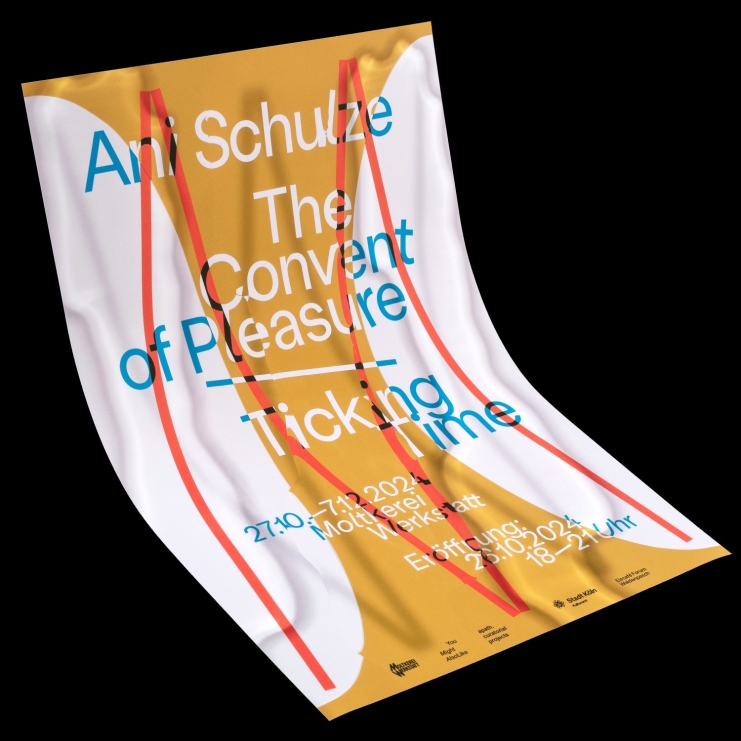The Convent of Pleasure - Ticking Time
Samstag und Sonntag, 15 bis 18 Uhr (Geschlossen am 10. und 24. November)
Öffnungszeiten zur Art Cologne:
8. November, 18 bis 21 Uhr
9. November 15 bis 21 Uhr (19 Uhr Führung durch die Ausstellung mit Ani Schulze und Alexander Pütz)
Die Ausstellung The Convent of Pleasure – Ticking Time von Ani Schulze präsentiert Episode 7: At One Go (2024) und Episode 1: The Beginning (2023) ihrer fortlaufenden Videoserie The Convent of Pleasure neben neuen Malereien und architektonischen Elementen. Die Reihe, die als Soap Opera angelegt ist, bezieht sich auf Margaret Cavendishs Komödie The Convent of Pleasure aus dem Jahr 1668, in der eine Gruppe von Frauen beschließt eine Gemeinschaft ohne Männer, das namensgebende Kloster zu gründen. Schulze greift in ihrer Videoserie sowohl fiktive als auch reale Frauenfiguren auf-meist Künstlerinnen - und entwickelt dabei hybride Charaktere sowie surreale Erzählfragmente.
Während Episode 1: The Beginning die Gründung des Klosters thematisiert, entfaltet Episode 7: At One Go eine Erzählung, die den Ausschluss aus der Gemeinschaft verhandelt. Der zweite Teil reiht sich chronologisch als Episode 7 in die Geschichte ein. In dieser, in Buenos Aires und Porto entstandenen Videoarbeit, scheint der Konvent zuerst gefestigt, in der Schilderung airy (dt. leicht) und mighty (dt. mächtig). Bereits zu Beginn wird der Schein durch eine zoomende, klickende Kamerafahrt in grünem Licht verfremdet und erweckt einen trügerischen Eindruck, der an städtische Überwachungssysteme erinnert. Die Atmosphäre ruft Reality-TV-Shows in Erinnerung - eine Inszenierung, in der auch das Beobachten und Beurteilen Teil der Unterhaltung wird. Ähnlich dem Format Big Brother – die argentinische Version Gran Hermano zählt 2024 zu den erfolgreichsten Fernsehshows des Landes – sind die Teilnehmer:innen einer ständigen Kontrolle ausgesetzt.
Der Titel At One Go (dt. auf einen Schlag) verweist auf die Dynamik von Spielen, in denen Entscheidungen schnell und willkürlich getroffen werden. In einem ungezwungenen Gewand, die intensive farbliche Inszenierung verstärkt dies, dreht sich alles um den Rauswurf der Bewohner:innen. Der Ausschluss wird durch kindliche Reime initiiert, deren Struktur und Intonation eine beklemmende Mischung aus Unschuld, Bedrohung und Ungewissheit schafft.
,.lp dip doo
The cat got the flu.
The donkey got the chickenpox.
So out goes you."
Dabei bleibt offen, ob die Bedrohung von innen oder außen ausgeht. So wird auch der Nereidenbrunnen der argentinischen Künstlerin Lola Mora (1866 -1936) zu einem (ausgeschlossenen) Charakter der neuen Serie. Diesen hatte die Bildhauerin 1903 für den Plaza de Mayo im Zentrum von Buenos Aires entwickelt. Eine Kontroverse – die nackten Körper der Meeresnymphen und Tritonen erschienen anrüchig, sodass das Kunstwerk an den Rand der Stadt verbannt wurde.
The Convent of Pleasure – Ticking Time entfaltet sich als installative Gesamtkomposition, in der Realität und Fiktion nahtlos miteinander verschwimmen und zusammen ein traumhaft-entrücktes Bild erschaffen. Die Videoarbeiten sind als filmische Collagen angelegt. in denen nicht lineare Handlungen in fragmentierten und widersprüchlichen Elementen verschmelzen. Die Ausstellung reflektiert aktuelle globale Entwicklungen der Exklusion zwischen oder innerhalb von Gesellschaften. wie deren Willkür. So entsteht eine Installation, die Humor und Brutalität verbindet, in der sich die Grenzen zwischen Kontrolle, Spiel und Ausschluss verschieben.
The exhibition The Convent of Pleasure – Ticking Time by Ani Schulze features Episode 7: At One Go (2024) and Episode 1: The Beginning (2023) from her ongoing video series The Convent of Pleasure. alongside new paintings and architectural elements. The series. designed as a soap opera. is inspired by Margaret Cavendish's 1668 comedy The Convent of Pleasure, in which a group of warnen decide to form a community without men-the titular convent. In her video series. Schulze draws on both fictional and real female figures-primarily artists- and develops hybrid characters and surreal narrative fragments.
While Episode 1: The Beginning focuses on the founding of the convent, Episode 7: At One Go teils a story about exclusion from the community. Chronologically, the second part is placed as Episode 7 in the narrative. In this video work, filmed in Buenos Aires and Porto, the convent initially seems well-established. portrayed as both airy and mighty. However, this impression is disrupted right from the start by a zooming, clicking camera movement under green light, creating a deceptive feeling reminiscent of urban surveillance systems. The atmosphere evokes the structure of reality TV shows-a staged environment where observation and judgement become integral to the entertainment. Much like the Big Brother format – with the Argentinian version, Gran Hermano, ranking as one of the country's most popular TV shows in 2024-the participants are subject to constant surveillance.
The title At One Go alludes to the fast-paced and arbitrary nature of games where decisions are made quickly. Everything revolves around the eviction of the residents. which is heightened by the playful staging. further enhanced by vivid colours. The process of exclusion is triggered by children's rhymes, whose rhythm and tone create an eerie blend of innocence, menace, and uncertainty.
lt remains ambiguous whether the threat comes from within or outside the community. The Nereid Fountain by Argentinian artist Lola Mora (1866-1936) also features as an (excluded) character in the new series. Mora originally created this sculpture in 1903 for the Plaza de Mayo in the centre of Buenos Aires. However, controversy arose-the naked bodies of the sea nymphs and Tritons were deemed inappropriate, and the artwork was subsequently banished to the outskirts of the city.
The Convent of Pleasure – Ticking Time unfolds as an immersive installation in which reality and fiction blend seamlessly, creating a dreamlike. otherworldly vision. The video works are structured as cinematic collages, merging non-linear actions into fragmented and contradictory elements. The exhibition reflects on current global dynamics of exclusion, whether between or within societies. and the arbitrary nature of these processes. The installation fuses humour with brutality. as the boundaries of control. play. and exclusion continuously shift.
Thanks to: Studio kela-mo: Paula Hohengarten & Moritz Zeller, Josef Zky, 235 Media: Peter Behle, Bernhard Adams, Wiebke Wesselmann, Josefine Ziebell, Temporary Gallery, Kryzstof Honowski & Olga Holzschuh
Design kela-mo
